How To Draw Panorama Of A Building
A spherical panorama is i that captures, not simply 360° around, simply all the way upwards and down besides. It captures every direction. I want to show you lot how you tin hand draw (or sketch, paint, etc.) these panoramas.
For example, here'due south my kitchen.

And if you can draw i that adheres to the equirectangular projection, yous can upload information technology to sites like Flickr and Facebook which provide interactive panorama viewers similar these ones:
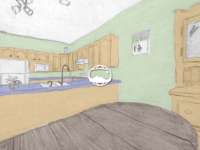
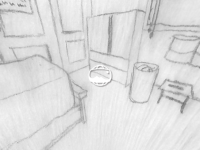
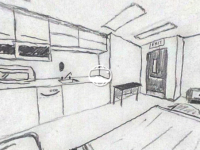

Paw drawn panoramas are an uncommon fine art grade but they aren't new. Artists like Dick Termes, Matthew Lopas, Jackie Lima, Arno Hartman, and Tom Lechner take been drawing or painting consummate or ultra-wide-angle panoramas for some time. Matthew Lopas' facebook page features many such paintings, and Tom Lechner'due south flickr group has more examples.
Fun right? Information technology seems in that location are as many ways to accomplish hand drawn panoramas every bit there are artists doing this. I can evidence you how I did mine. Follow along.
Footstep 0 – Get familiar with equirectangular projections
It is a practiced idea to become familiar with what an equirectangular project is before you lot head out to depict one. Skip to step 1 if you are. If not, here'south 1 now!

An equirectangular projection maps your surroundings to a rectangle with 360 as spaced degrees from the left to right and 180 equally spaced degrees upwardly and downwards. Have a look at the equirectangular grouping on Flickr for more than examples. Notice how the the left side wraps effectually and continues on the right. Besides observe how the top and lesser get all stretched out.
Let's do a demonstration. From where yous are sitting now, notice that an edge coming from one corner of a ceiling will exist angled upwards. Practise it. Look up from your screen. Then, scanning along the height of the wall to a point correct in forepart of you, that edge will be level. Moving farther, the corner will be at a downward bending.

Actually that's all an equirectangular projection is doing. It's changing the orientation of things to appear every bit they do when you plough your caput to browse the room.

The method below helps the states draw these curves properly.
Step i – Get setup
Pick a location with plenty of rectangular shapes and lines.
Get your drawing materials: pencil, eraser, easel, and newspaper.
Download and print a version of this equirectangular perspective grid. Legal size paper (8.five″×14″) is a bully size for this purpose.

I accept two means of superimposing (subimposing?) this grid onto paper. The first one is straightforward. Use tracing newspaper and record or pin information technology downwards on top of the grid. The second is to print the grid onto the back of the paper y'all're drawing on. So, when yous're cartoon, make certain the paper is on a low-cal surface so that the black lines on the dorsum of the newspaper prove through.
Step 2 – Locate your surroundings onto the grid
Align yourself with your surroundings. Choice a wall or a building to be forrad and face it squarely. At present yous can associate six master existent-life directions with these locations on your filigree:
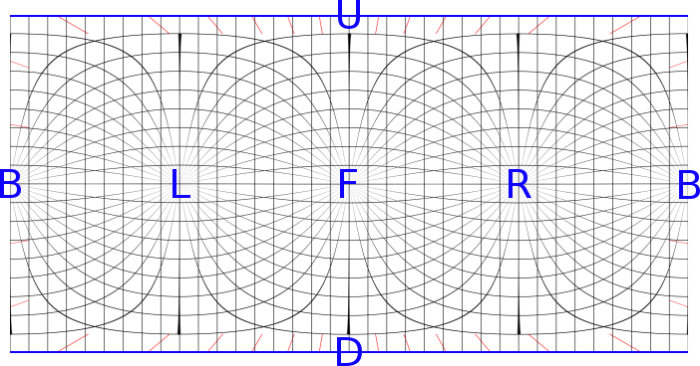
The sets of lines emanating from each of these directions are spaced 10° apart. One set up of lines get from straight forward to straight back, ane goes from left to correct and the third gear up go upwardly and down.

Your job now, is to effigy out where each item in your environs belongs on the grid paper. You lot need to measure 2 angles. The outset is the horizontal angle between straight forwards and your object: theazimuth. The 2d is the vertical angle betwixt your object and the horizon: thealtitude.
Azimuth
 If you're lazy and don't care as well much nearly accurateness like me, you can follow the astronomers' tricks described here to measure out angles from the known points in your scene.
If you're lazy and don't care as well much nearly accurateness like me, you can follow the astronomers' tricks described here to measure out angles from the known points in your scene.
Another method uses the red marks that I placed the edge of the perspective graph paper. With your newspaper level, each scarlet tick mark will indicate the direction from the center of the paper out towards your environment in 10° increments.
A third way is to employ a compass app on your smartphone. You'll have to exercise a piddling math. For instance, if your compass says 97° when facing frontwards and it says 128° when facing an object so the object has an azimuth of 128° – 97° = 31°.
Altitude
To measure out upward (or down) from the horizon, imagine the horizon line and then use those astronomer tricks again.
For a more mechanical method, what you lot desire is a clinometer. Look online for how to make one yourself – you can fifty-fifty buy them ready made.
And of course your smartphone can do this also. Many level apps have a clinometer manner. Just look forth the long edge of your phone similar a sight.
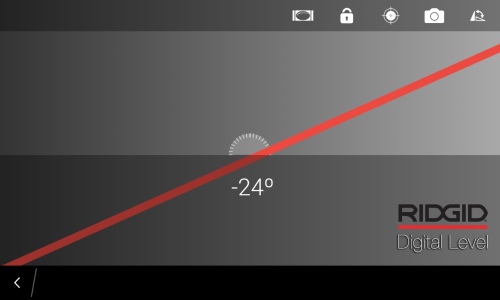
At this point, it's practiced to mention that it'south up to you lot to determine how contained you wish to be from technology. If you get also far, you might as well but trace a picture taken past a spherical photographic camera. On the other side of the spectrum you can just forgo the grid and wing the whole matter. What I do, is I proceed the grid newspaper, only I exercise without the smart phone apps.
Locate your point on the grid
And then, now that y'all take the altitude and azimuth of a point in space, you tin find where it is on your filigree. You lot'll want to locate the altitude start. Here's an example. Say your altitude is 65° and your azimuth is -45°. Starting at forward, get half dozen½ lines upwardly, and then iv½ lines to the left.
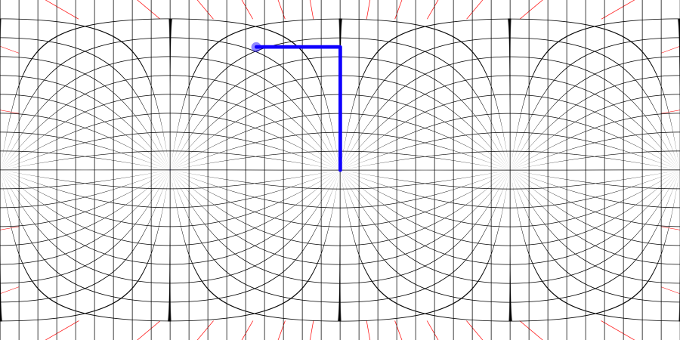
Step 3 – Draw!
Draw the direct lines of your scene in the same manner as a 2-point perspective cartoon. That is, if the line in the scene is plumb, draw the line vertically. If the line is forwards / backwards, follow the management of the lines that go between the forwards / backwards vanishing points. If your line in the scene goes left to right, follow the lines that go between the left / right vanishing points.
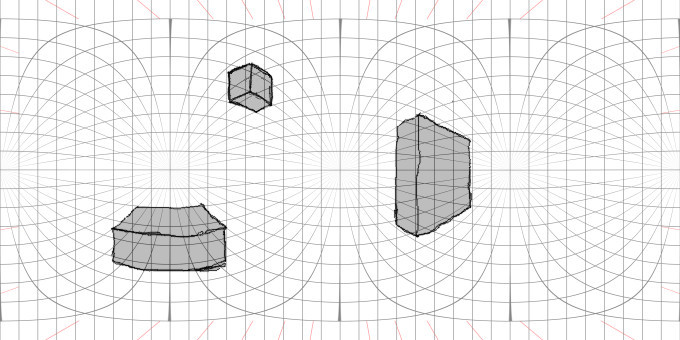
I similar to start straight forrad and build outwards.
You may rely on previous line placements. Say you've drawn i corner of a rectangle, follow the edge along the graph-paper lines to go to the side by side corner.
It might help to encompass imperfections. If lines aren't coming together up where they should be, look for compromises.
In an equirectangular projection, the top and lesser get extremely distorted. So cartoon your chair might exist difficult. More often then not however, the space direct higher up you (the zenith) and the infinite below you (the nadir) are rather featureless.
Do more! This method will layout your scene but for sky'south sake, if you lot accept a favourite medium (pen and ink, paint, digital painting, woodcut press, watercolor, etc.), so by all ways use information technology.
Step iv – Scan, upload and share
Mark the corners of the sketch. They'll be useful when you ingather and align your scanned picture.
If you have grid printed on the dorsum of your paper, scan or photograph your drawing with a dark paper backside it. The grid will disappear, and only your drawing volition stand up out. But if you lot used tracing paper, put a white paper behind it.
Once you've scanned your picture, photo editing software tin can help you straighten, crop and scale information technology to friction match the 2:1 aspect ratio.
Y'all can share it as is. Only to become the immersive view on Flickr, tag your image with the tag 'equirectangular'. For Facebook, things are a lot trickier. Y'all have to set the paradigm's metadata earlier uploading information technology.
Personally, I similar to transform spherical panoramas using interesting mathematical mappings. This gives me a run a risk to 'compose' the epitome into something dynamic. Stereographic images ordinarily turn out very nicely.
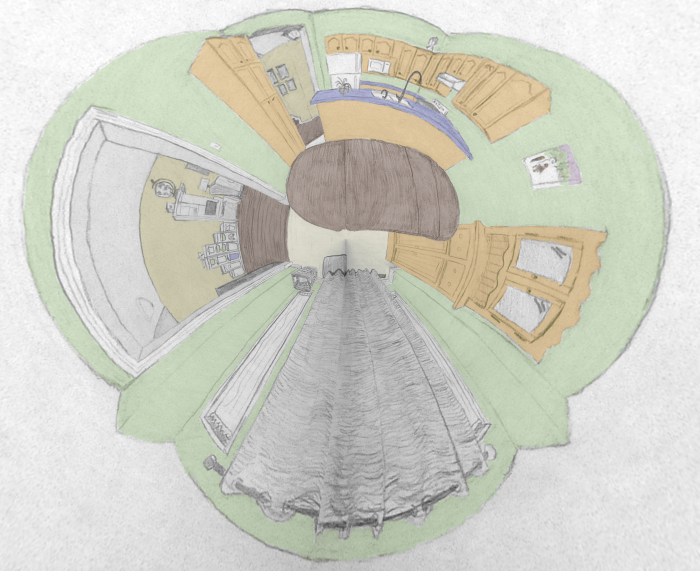
Source: https://dmswart.com/2016/06/28/drawing-a-panorama/
Posted by: hamiltonwathre.blogspot.com



0 Response to "How To Draw Panorama Of A Building"
Post a Comment